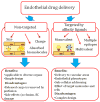Targeted endothelial nanomedicine for common acute pathological conditions
- PMID: 26435455
- PMCID: PMC5450650
- DOI: 10.1016/j.jconrel.2015.09.055
Targeted endothelial nanomedicine for common acute pathological conditions
Abstract
Endothelium, a thin monolayer of specialized cells lining the lumen of blood vessels is the key regulatory interface between blood and tissues. Endothelial abnormalities are implicated in many diseases, including common acute conditions with high morbidity and mortality lacking therapy, in part because drugs and drug carriers have no natural endothelial affinity. Precise endothelial drug delivery may improve management of these conditions. Using ligands of molecules exposed to the bloodstream on the endothelial surface enables design of diverse targeted endothelial nanomedicine agents. Target molecules and binding epitopes must be accessible to drug carriers, carriers must be free of harmful effects, and targeting should provide desirable sub-cellular addressing of the drug cargo. The roster of current candidate target molecules for endothelial nanomedicine includes peptidases and other enzymes, cell adhesion molecules and integrins, localized in different domains of the endothelial plasmalemma and differentially distributed throughout the vasculature. Endowing carriers with an affinity to specific endothelial epitopes enables an unprecedented level of precision of control of drug delivery: binding to selected endothelial cell phenotypes, cellular addressing and duration of therapeutic effects. Features of nanocarrier design such as choice of epitope and ligand control delivery and effect of targeted endothelial nanomedicine agents. Pathological factors modulate endothelial targeting and uptake of nanocarriers. Selection of optimal binding sites and design features of nanocarriers are key controllable factors that can be iteratively engineered based on their performance from in vitro to pre-clinical in vivo experimental models. Targeted endothelial nanomedicine agents provide antioxidant, anti-inflammatory and other therapeutic effects unattainable by non-targeted counterparts in animal models of common acute severe human disease conditions. The results of animal studies provide the basis for the challenging translation endothelial nanomedicine into the clinical domain.
Keywords: Drug delivery; Vascular immunotargeting.
Copyright © 2015 Elsevier B.V. All rights reserved.
Figures




Similar articles
-
Vascular targeting of nanocarriers: perplexing aspects of the seemingly straightforward paradigm.ACS Nano. 2014 May 27;8(5):4100-32. doi: 10.1021/nn500136z. Epub 2014 May 7. ACS Nano. 2014. PMID: 24787360 Free PMC article. Review.
-
Targeting delivery of drugs in the vascular system.Int J Transp Phenom. 2011;12(1-2):41-49. Int J Transp Phenom. 2011. PMID: 25328360 Free PMC article.
-
Targeting drug delivery in the vascular system: Focus on endothelium.Adv Drug Deliv Rev. 2020;157:96-117. doi: 10.1016/j.addr.2020.06.013. Epub 2020 Jun 21. Adv Drug Deliv Rev. 2020. PMID: 32579890 Free PMC article. Review.
-
Dynamic factors controlling targeting nanocarriers to vascular endothelium.Curr Drug Metab. 2012 Jan;13(1):70-81. doi: 10.2174/138920012798356916. Curr Drug Metab. 2012. PMID: 22292809 Free PMC article. Review.
-
Targeting vascular inflammation through emerging methods and drug carriers.Adv Drug Deliv Rev. 2022 May;184:114180. doi: 10.1016/j.addr.2022.114180. Epub 2022 Mar 7. Adv Drug Deliv Rev. 2022. PMID: 35271986 Free PMC article. Review.
Cited by
-
Biomimetic Oil-in-Water Nanoemulsions as a Suitable Drug Delivery System to Target Inflamed Endothelial Cells.Nanomaterials (Basel). 2024 Jul 31;14(15):1286. doi: 10.3390/nano14151286. Nanomaterials (Basel). 2024. PMID: 39120393 Free PMC article.
-
Tree of life: endothelial cell in norm and disease, the good guy is a partner in crime!Anat Cell Biol. 2023 Jun 30;56(2):166-178. doi: 10.5115/acb.22.190. Epub 2023 Mar 7. Anat Cell Biol. 2023. PMID: 36879408 Free PMC article. Review.
-
Theoretical design for covering Engeletin with functionalized nanostructure-lipid carriers as neuroprotective agents against Huntington's disease via the nasal-brain route.Front Pharmacol. 2023 Jul 10;14:1218625. doi: 10.3389/fphar.2023.1218625. eCollection 2023. Front Pharmacol. 2023. PMID: 37492081 Free PMC article.
-
Nanocarriers for targeted drug delivery in the vascular system: focus on endothelium.J Nanobiotechnology. 2024 Oct 12;22(1):620. doi: 10.1186/s12951-024-02892-9. J Nanobiotechnology. 2024. PMID: 39396002 Free PMC article. Review.
-
Overcoming Vascular Barriers to Improve the Theranostic Outcomes of Nanomedicines.Adv Sci (Weinh). 2022 May;9(13):e2103148. doi: 10.1002/advs.202103148. Epub 2022 Mar 4. Adv Sci (Weinh). 2022. PMID: 35246962 Free PMC article. Review.
References
-
- Pagano RE, Weinstein JN. Interactions of liposomes with mammalian cells. Annu Rev Biophys Bioeng. 1978;7(1):435–468. - PubMed
-
- Gregoriadis G. Liposomes in therapeutic and preventive medicine: the development of the drug-carrier concept. Ann N Y Acad Sci. 1978;308(1):343–370. - PubMed
-
- Ryman BE, Tyrrell DA. Liposomes — methodology and applications. Front Biol. 1979;48:549–574. - PubMed
-
- Juliano RL. Drug delivery systems: a brief review. Can J Physiol Pharmacol. 1978;56(5):683–690. - PubMed
-
- Langer RS, Peppas NA. Present and future applications of biomaterials in controlled drug delivery systems. Biomaterials. 1981;2(4):201–214. - PubMed
Publication types
MeSH terms
Grants and funding
LinkOut - more resources
Full Text Sources
Other Literature Sources

